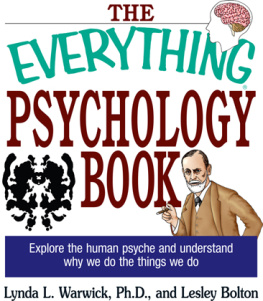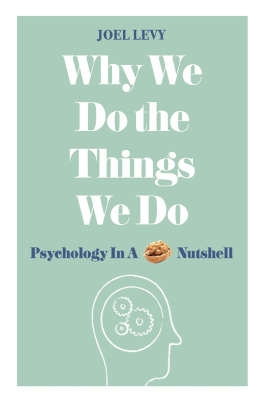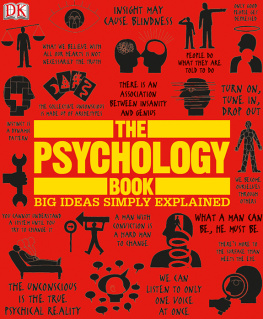psychology ideas
you really need to know

Adrian Furnham

Contents
A DISEASED MIND
ILLUSION AND REALITY
HEARTS AND MINDS
INDIVIDUAL DIFFERENCES
PERSONALITY AND SOCIETY
RATIONALITY AND PROBLEM SOLVING
COGNITION
DEVELOPMENT
LEARNING
THE BRAIN
Introduction
Psychology has its advocates and detractors. Some think of it essentially as the queen of the social sciences whose progress, insights and applications are keys to health, happiness and progress. Detractors see psychologists as deluded and even dangerous perpetrators either of commonsense or wrong ideas and practices.
The official birth of psychology was in the 1870s. Psychologists have been highly regarded international figures of influence. It could be argued that along with Darwin and Marx, Freud was the most influential thinker of the 19th century. Watson, Skinner, Milgram and others had a high impact on the way people do everything from raise and educate their children to how they select and manage people at work. And in the 21st century, a psychologist, for the second time, won the Nobel Prize for Economics.
Psychology is everywhere in todays society. No crime fiction, documentary, chat show, or medical consultation is complete without the introduction of a psychological angle. The design of your car, your house, your choice of clothes, consumables and partners, the way we teach our childrenall have been the topic of, and influenced by, psychological research. It also has an accepted role in management, sports and consumer marketing.
Psychology is both a pure and applied science. It aims to understand behavior and the basic mechanisms and processes that influence ideas, feelings and thoughts. It also tries to solve human problems. It is very multidisciplinary, having close connections with many other subjects including anatomy, medicine, psychiatry and sociology as well as economics, mathematics and zoology.
Newcomers to psychology are often surprised by the range of things that psychologists studyfrom dreaming to delusions of grandeur; computer phobia to the causes of cancer; memory to social mobility; attitude formation to alcoholism. Importantly and usefully, psychology teaches people a rich vocabulary through which they can describe and explain behavior: psychology teaches the student the language of behavioral description and explanation.
Some psychological theories are counterintuitive and some are quite commonsensical. I hope that in this book I have made sense of the former and clarified the latter.
Abnormal behavior
Abnormal psychologyalso referred to as clinical psychologyis the study of abnormal behaviors. It looks at the origins, manifestations and treatments of disordered habits, thoughts or drives. These may be caused by environmental, cognitive, genetic or neurological factors.
Abnormal psychologists are concerned with the assessment, diagnosis and management of psychological problems. They are both scientists and practitioners who often specialize in the treatment of various disorders like anxiety disorders (anxiety, panic, phobias, post-traumatic stress disorders); mood disorders (depression, bipolar disorder, suicide); substance disorders (alcohol, stimulants, hallucinogens, etc.); or very complex problems like schizophrenia. Clinical psychology is part, but by no means the central part, of psychology. It is certainly associated by lay people as the most interesting and important specialism in applied psychology.
Defining abnormality While it is relatively easy to spot people who are distressed or acting bizarrely, it is much more difficult to define abnormality. Abnormal means departure from the norm. So very tall and very short people are abnormal, as are very backward and very gifted people. Thus, strictly speaking, Einstein and Michelangelo were abnormal, as were Bach and Shakespeare.
For clinical psychology, the issue is not so much whether the behavior is abnormal, as whether it is maladaptive, causing a person distress and social impairment. If a persons behavior seems irrational or potentially harmful to themselves and others, we tend to think of that as abnormal. For the psychologist it is called psychopathology; for the lay person, madness or insanity.
We would all like the certainty and clarity of a precise distinction between normal and abnormal. Yet we know that history and culture shape what is considered abnormal. Psychiatric textbooks reflect this. Homosexuality was not that long ago considered a mental illness. Masturbation in the 19th century was thought of as abnormal.
The years have layered onto this term (i.e. abnormal) too many value judgments and any number of synonyms are preferable: maladaptive, maladjusted, deviant, etc.
A. Reber, 1985
Socio-economic status, gender and race are all related to abnormality. Women are more likely to have anorexia, bulimia or anxiety disorders than men, who, in turn, are more likely to be substance abusers. Poor people are more likely to be diagnosed schizophrenic than rich people. American children suffer a high incidence of disorders of undercontrol compared to overcontrol, but that is the opposite way around in the West Indies.
Early approaches to abnormality saw bizarre behavior as spirit possession. People believed in animalismthe belief that we are similar to animalsand that madness was the result of uncontrolled regression. Ancient Greeks saw abnormality and general malaise as caused by bodily fluids or humors. As a result, early treatment of the insane was mostly involved in segregating them and then punishing them. Humane treatment didnt really appear until the 19th century.
Generally agreed-upon criteria Today, psychological definitions of abnormality revolve around a handful of generally agreed-upon criteria. These have been classified as the 4Ds: distress, deviance, dysfunction, danger. Abnormality generally involves pain and suffering, one aspect of which is acute and chronic personal suffering. One criterion is poor adaptationnot being able to do the everyday things of life, such as hold down a job, maintain happy interpersonal relationships or plan for the future.
A very common criterion is irrationalitybizarre, illogical beliefs about the physical or social world as well as, very often, the spiritual world. The behavior of abnormal people is often incomprehensible to others. They are often unpredictable; they can be very volatile, changing from one extreme to another and often quite unable to control their behavior. Their behavior is often very inappropriate.
Almost by definition their abnormality is characterized by unconventional, usually rare, undesirable behaviors. In addition, abnormality has a moral dimension. It is associated with breaking rules, violating moral standards and disregarding social norms. Illegal, immoral, undesirable behavior is abnormal.
One rather interesting criterion of abnormality is the discomfort that is generated in people around abnormal behavior. Observers often feel uncomfortable around clear evidence of abnormality.
She always says she dislikes the abnormal, it is so obvious. She says the normal is so much more simply complicated and interesting.
G. Stein, 1935
The problems of the concept The problems with any definition of abnormality are clear. Firstly, a healthy person in an unhealthy society is often labeled as abnormal. There are many examples where societies have been deeply intolerant of those who dont obey their narrow (unhealthy, maladaptive) standards of belief and behavior. Secondly, of course, expert observers cant agree on the categorization of normal vs. abnormal. Even when multiple criteria of abnormality are specified, there remains fundamental disagreement about whether a person is considered in some sense abnormal. Thirdly, there is the actor-observer difference: who is to make the judgment? Actors rarely think themselves abnormal: most of us are reasonably positive about ourselves and indeed have a great deal of information others do not have. Yet there are well-known traps and hazards in making a self-diagnosis. It is easier to be observers and label others abnormal, particularly those different from us or threatening to us.










